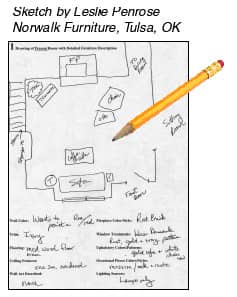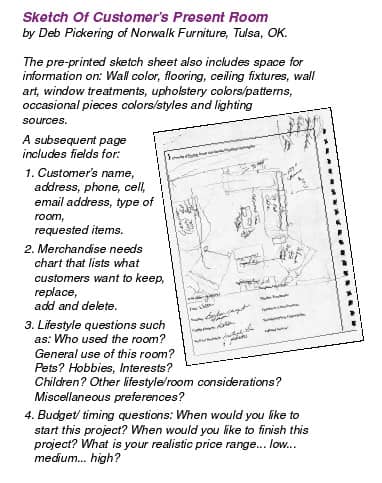If the room sketches retail sales and design associates draw could speak, they would say, “draw me, use me, profit from me.”
Hey there. Where’d you go? I’m the room sketch you drew when you met with your customer “Ethel” for the first time. You can call me your Sketchee. You, the Sketchor, are now responsible for my well being and livelihood. But what do you do? You ignore me. You thumb past me day after day, wrinkling my corners and don’t give me a second thought. Did you forget about all the time you spent drawing me? Don’t you remember how you and I brought our customer’s new room to life?
You spent a lot of time finding out about “Ethel,” her space, and sketching her room. Where is your return on this investment of time and energy?
Besides thumbing through me everyday, how are you using your sketch book? Are you using your sketch book? Do you have one? Do you know where it is? If not, then dig it out and dust it off.
Isn’t your time worth money? You’ll never get it back if you just let me sit here on page 22 of your sketch book. Are you treating all of my brothers and sisters the same way? After all, the care and feeding of all of us Sketchees is very important. You created us. You are now responsible for our usefulness, or lack thereof. I know, I know, you don’t like us very much. You have been told time and time again about the importance of creating room sketches. You MUST do this! YOU MUST SKETCH! How many times have you heard those words? About a trazillion? There have been contests held in my name. Goals have been given. Enticing bribes have been delivered. You may even have been threatened by management to make sure that you know that I, your Sketchee, am a big deal. Even after all this emphasis, you’re still not comfortable sketching. Perhaps it is my fault. I’ve never taken the time to explain to you how simple it is to create sketches that will help you to close sales and make you money.

So let’s look at the WHY’s, the HOW’s, and the WHAT’s of sketches. We will take special care to explain what to do with me once I’m in your book. I am, after all, one of the greatest selling tools in your arsenal. Yep, that’s right, I am. I am the skill that takes you right out of clerkdom and into the land of the consummate professional. You didn’t know I had so much clout did you? There’s a whole lot to me, right here on page 22!
Let’s start with why it is so important to adopt me, the Sketchee. Why is it in your best interest, and “Ethel’s” to sketch.
First, I make your job easier. The entire process becomes more fun for both you and your customer.
Next, together we can get her talking about her room, even though she told you that all that she needed was a sofa. This conversation will help her to start to picture what is in there, and what isn’t! Her room will come to life in a whole new way. You will both start to see her needs emerge and become a reality as I emerge in black and white on the page.
Then, what we, in the Sketchee trade, call the “instant partnering process” is created. This will put you in a whole different league from all those clerks out there. Professionals become partners with their clients. Clerks sell to their customers. Clerks react when “Ethel” says she needs a sofa by racing her all over the showroom floor, showing her every sofa and every product catalog. The purpose of all this mindless activity is to get “Ethel” to pick one! The clerk makes it all about him or herself and the product. This tactic moves this poor consumer right into the land of confusion. Her eyes glaze over, and her head starts to hurt. She becomes confused and overwhelmed. She doesn’t remember what she has seen, and may even forget what she wants. She just knows that she wants to get out of the store!
Clerks confuse. They react. Professionals respond. They know that their goal with each and every customer is to find out:
•WHO their customers are. (Professionals get their customers’ names early in the selling process.)
•WHY customers are there. (Professionals ask people questions.)
•WHAT customers want. (Professionals listen to their customers’ needs.)
•HOW they can help customers. (Professionals come up with creative solutions.)
•WHEN customers want it. (Professionals find out their customers’ time schedules to create a sense of urgency and avoid disappointments.)
Make getting this information with each and every “new up” your goal. Once this information has been uncovered, you will turn each “up” into a “new opportunity.”
It’s easy to start the drawing process by asking these important people questions:
• “Where will you be using your new sofa.”
• “What room.”
• “Who will be using the room.”
• “Tell me all about your family.”
• “How will you be using your new room?”
The answers you get to these questions will help to organize your partnership with Ethel and, if you will forgive the pun, make sure that you and “Ethel” are on the same page! THAT page is me, page 22 in your sketch book. My adoption becomes official as you both start drawing together and your customer becomes your client.
As a professional, there are several rules you need to follow if you want to work effectively as the Sketchor of “Ethel’s” room:
RULE #1:
Never say these words again.
1. “I’m a visual person. I need to see the room.”
2. “It helps me to see what you’re talking about in black and white.”
3. “I need to see your room on paper.”
4. “It’s important to me to draw your room so I know what you’re talking about.”
So-o-o What! All of the above phrases are about what you need, not about “Ethel,” and what she wants. She doesn’t care if you’re “visual.” She probably doesn’t really know what that even means! Her wants, her needs, her dreams are what is important. That’s why she’s here! Helping her to find out, to get those answers are why you’re here! You need to tell her that you are there to make it easier for her. You are there to make the process more fun, and less fearful.
RULE #2:
Be careful to make it clear who is helping whom. Don’t say, “Would it help if we sketched your room?” “Ethel” already knows what her room looks like!
Instead use these 14 magic words that will make your company “Me, Inc.” much more successful. “Let’s draw your space together, so we can bring your new room to life.”
Creating a sketch does just that. It brings her room to life. Now her dream starts to become real, and the whole process focuses on her!
Once you’ve told her what you will be doing in the proper way, the professional process of partnering with this person can begin.
“There is a life-force, an energy, a quickening that is translated through you into action. If you block it, it will never exist through any other medium and be lost. The world will not have it. It is your business to keep the channel open.” -Martha Graham

Bring out your energy. Let your vitality as a professional set you apart. Let me, the “Sketchee” help you shine! Together we’ll take your new “UP,” this person named “Ethel,” from customer to client. Your job is to let her know that you are the pro, who is listening to her, and clarifying what is actually being said.
While you are helping your client, you also want to make sure that you are helping yourself. Your time is your money, so invest it wisely. Are you depleting your limited resources with customers or are you getting a return on your time with clients?
I, me, page 22, am your most important resource. Use me to turn your drawings into gold for you and “Ethel.”
You spent a lot of time finding out about “Ethel,” her space, and sketching her room. How are you getting that time back? Besides thumbing through me (your sketch book) everyday, how are you using your sketch book? For those of you sales and design associates who don’t have one, get one. You can’t effectively conduct business for your company without me. I make you, the professional stand out above all the other clerks. I make it easy for you, and I, the Sketchee, make it fun for “Ethel” to get involved with you, and the creation of her new room. Who wouldn’t want to play and participate in painting your new masterpiece.
Do you know where all of us sketches are dwelling? Dig us out. Dust us off. Take all the information that you collected when drawing me and my siblings, and use us to follow-up.
If you use a card file system, make sure that I am attached to one! Spiral notebooks are the not most efficient, but okay. The problem with spiral notebooks is that they become disorganized... just one page turner after another.
If you are comfortable with your follow-up system and it works for you, use it. However, you must remember to use it because sketching makes customer information accessible. Sketching sets you apart as the professional. Sketching gives you a professional edge so that you stand out, and stand above the rest! Seth Godin, author of “The Purple Cow,” and “Unleashing the Ideaviruus,” calls it “edgecraft.” I call it terrific, and so will you!
Here’s to your Success & YOUR EDGE!
-Regards, Your “Sketchee”
Cathy Finney is President of Ancell Affiliates\”T ‘N T.” She is a noted motivational speaker, sales trainer, and management consultant. Questions on any aspect of sales training or sales management can be sent to Cathy at finney@furninfo.com.